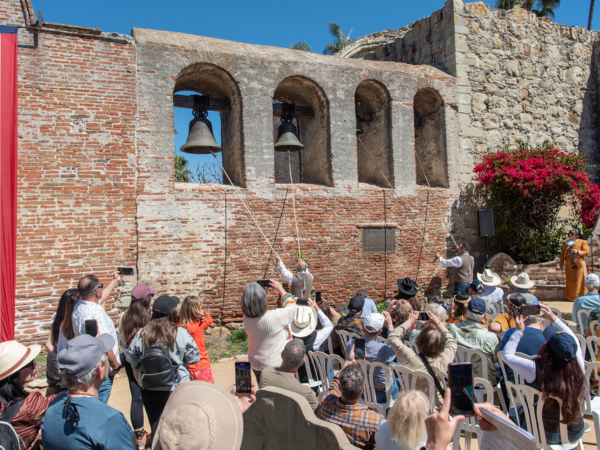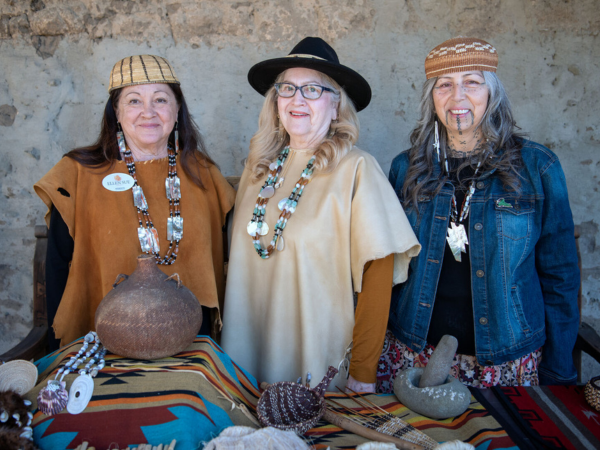A SICKLY PRIEST FROM Kentucky, a little gray songbird and St. Joseph saved the once-crumbling Mission San Juan Capistrano, one of Orange County’s most revered historical landmarks. More than a century later, the Mission still celebrates how God can work miracles even through His most humble creatures.
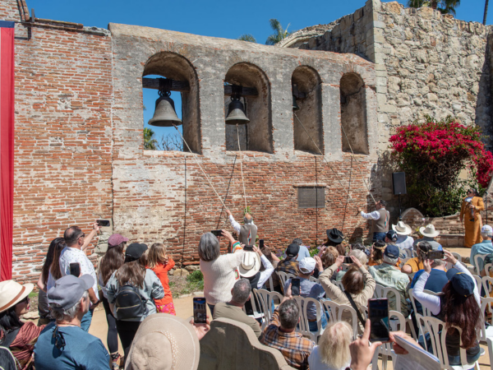
OFFICIAL BELL RINGERS MICHAEL GASTELUM, RIGHT, AND NATHAN BANDA, MEMBERS OF THE ACJACHEMEN PEOPLE, RING THE HISTORIC BELLS IN HONOR OF ST. JOSEPH AND THE SWALLOWS’ RETURN DURING ST. JOSEPH DAY AND RETURN OF THE SWALLOWS FESTIVAL ON MARCH 19. PHOTOS BY JEFF ANTENORE/DIOCESE OF ORANGE
In July 1910, Fr. John O’Sullivan made his last stop on a long trek through the Southwest to find a place to minister in a climate conducive to someone with Tuberculosis, a deadly respiratory disease. As a last resort, he was told to go to the Mission San Juan Capistrano, which was so decrepit that it was not even considered a parish. But he pitched his tent and began rebuilding the ruins.
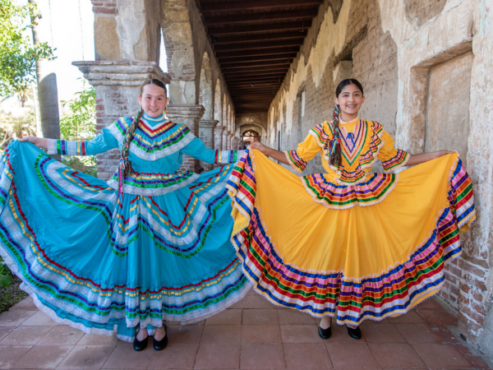
MISSION BASILICA SCHOOL 8TH GRADERS MUKAELA CLERKIN, LEFT, AND JOCELYN WOOD, SHOW OFF THEIR ELABORATE DRESSES BEFORE PERFORMING WITH THEIR CLASSMATES DURING THE ANNUAL ST. JOSEPH’S DAY AND RETURN OF THE SWALLOWS FESTIVAL.
A kindly man, Fr. O’Sullivan, noticed shopkeepers smashing the mud nests that little swallows had built in the eaves of roofs. The story goes that Fr. O’Sullivan invited the birds to nest in the eaves of the crumbling Mission, which they did in droves. Much to his delight, he learned that the birds were migratory and left to winter below the equator, returning yearly around St. Joseph’s feast day, March 19. That happened to also be Fr. O’Sullivan’s birthday.
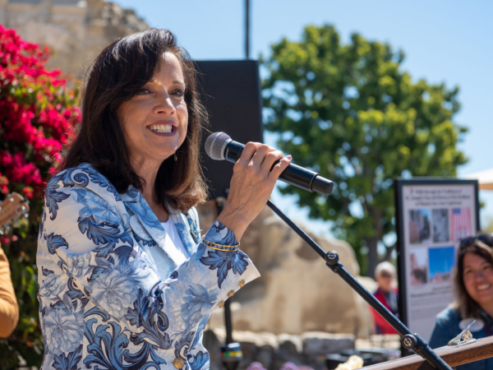
MISSION SAN JUAN CAPISTRANO EXECUTIVE DIRECTOR MECHELLE LAWRENCE ADAMS WELCOMES VISITORS TO THE RINGING OF THE HISTORIC BELLS DURING THE ANNUAL ST. JOSEPH’S DAY AND RETURN OF THE SWALLOWS FESTIVAL AT THE MISSION.
Fr. O’Sullivan put St. Joseph, the patron saint of carpenters and his birthday together and devised a way to raise money — he threw a birthday party on St. Joseph’s feast day to fund the preservation. He charged visitors 10 cents to view the grounds. The Mission began to come back one adobe brick at a time. People also came back, along with the swallows, and soon, the Diocese of Monterrey-Los Angeles made the Mission an official parish.

ELLEN SUE OLIVARES, PATRICIA DIXON AND HEIDI LUCERO, MEMBERS OF THE ACJACHEMEN PEOPLE, SHOW VARIOUS NATIVE AMERICAN ARTIFACTS TO VISITORS OF MISSION SAN JUAN CAPISTRANO.
One hundred and fifteen years later, the party has become an annual festival. Under the leadership of Mechelle Lawrence Adams, executive director of the Mission, the Preservation Commission has made great strides toward completing Fr. O’Sullivan’s work.
“I was hired as a preservationist 22 years ago to put us on a path to bring the history to life through education programs celebrating the Indigenous community and their contribution to building the Mission,” said Lawrence Adams.
Since then, the foundation has spent more than 20 million dollars to restore the structure and enhance the gardens.
“We are trying to stabilize the columns now, and the perimeter walls,” she said. “We have a painting collection that needs conservation that we need to finish.”
But the swallows and the kids are the main attraction on March 19, St. Joseph’s Day. After Mass, the Mission’s historic bells ring in the opening of the St. Joseph’s Day & Return of the Swallows Celebration, followed by mariachi bands. The event also includes a lavish St. Joseph’s table hosted by foundation board member Vicky Carabini. The table features a traditional Italian assortment of foods for purchase. Proceeds are part of an ecumenical effort to feed those in need locally.
Dr. Charles R. Brown, an expert on Cliff Swallows, presented a lecture on these famous little creatures. Visitors could also tour the St. Junipero Serra exhibits and those on the Indigenous people, their lives and their contributions.
But the highlight is the children. With the bells ringing, the children of the Mission Basilica School and San Juan Elementary School kindergarten and TK parade into the courtyard in costume to perform traditional songs and dances.
The younger students steal the show in their colorful swallows costumes and dance “The Chicken Song” (not precisely traditional music, but cute as can be). First-grade “monks” follow them in brown robes. Each class up through eighth grade participates.
Since they first came to the Mission Basilica school, eighth graders Mykaela Clerkin and Jocelyn Wood have paticipated in St Joseph’s Day events. This year, they dressed in traditional Mexican dress. Their teacher, Karen Prukop, enjoys teaching in an environment steeped in California history.
“The students don’t realize it now,” she said. “But it’s in the air they breathe, and they will come back one day and realize how much of a gift it was to go to school in a place like this. They will return and remember today and how blessed they were to be here.”
Lawrence Adams added, “It’s fascinating to me, the number of people I have met coming to the St. Joseph’s Day celebration because it’s on their ‘bucket list’. They have told me, ‘I want to be here on this day.’ Maybe it’s their birthday, too, or their name is Joseph. They have heard about the swallows returning to Capistrano, many of which are from the famous 1940s song. But regardless of the reason, they leave with so much more. Some might call it inspiration, hope, education, respect or reverence. But St. Joseph’s Day is the day to put this Mission in the spotlight and serve the community something special.”
Fr. John O’Sullivan succumbed to his disease in 1933 and is buried on the Mission grounds, not far from the festivities. Sometimes he is called a saint but has not been officially canonized. However, it is easy to picture him surrounded by St. Francis of Assisi, St. Junipero Serra and most of all, St. Joseph — singing “When the Swallows Come Back to Capistrano.”


